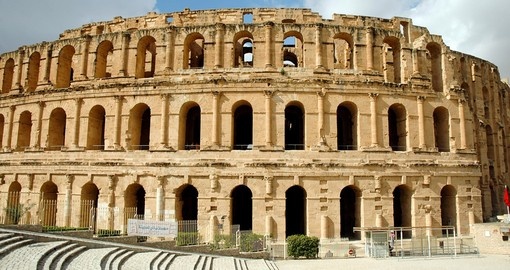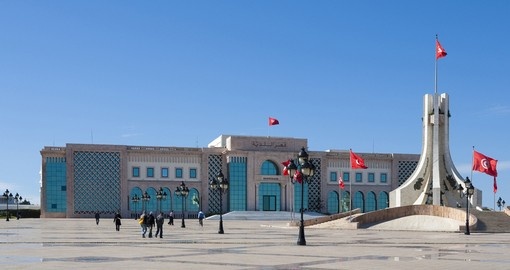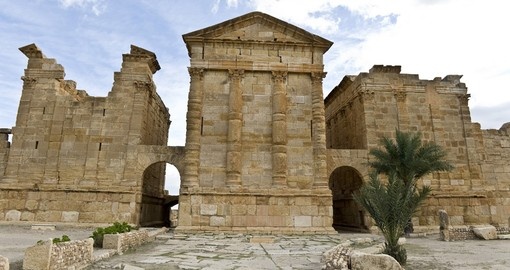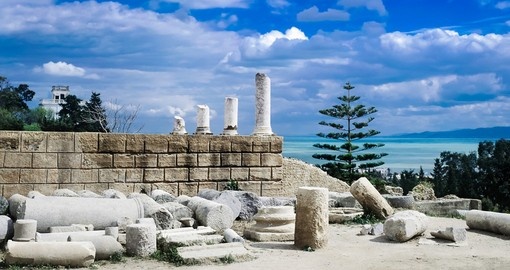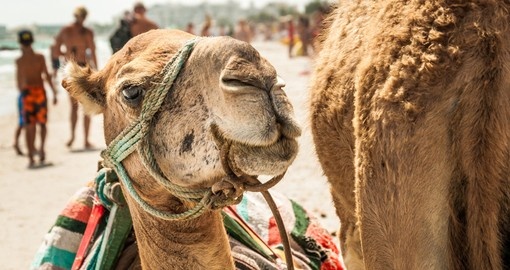SITES WORTH VISITING The mosaics collection of the Bardo museum, the richest in the world (approximately 90,000 square meters); the El Jem Coliseum, third in importance after Rome and Verona's amphitheaters; Antonin's thermal baths in Carthage, also the third most important in the Roman empire. Numerous visitors to Tunisia include these visits in their program along with the Tunisian "Pompei's" of Dougga, Bulla Regia or Sbeitla and Kerbouane. Sites reflecting the importance of the civilization center which, over several periods of time, were ancient Tunisia. KERBOUANE Kerbouane is an exceptional site included in the UNESCO World Heritage List, which will enable us to get to know the Punic civilization, the first great civilization of the western Mediterranean. This was a fascinating civilization originating from the Middle East which became acclimatized to Africa and built an empire which expanded to Sardinia and Spain. In Kerbouane, the vestiges of an entire city can be viewed and one can decipher the town planning specific to the Carthaginian cities – wide avenues in a checkered pattern, houses built around an inside patio each equipped with a bathroom with a hip bath. DOUGGA Dougga, one of the most important sites of the country has a Libyco-Punic mausoleum, a capitol, a theater, thermal baths, monumental arches, temples and extremely well-preserved houses forming a very impressive whole. BULLA REGIA In Bulla Regia can be found a unique case of Roman houses with an underground floor; its thermal baths are among the best preserved in Tunisia. Of Numidian origina, Dougga and Bulla Regia are most representative of the Romano-African civilizations, an original and brilliant civilization which witnessed the birth of numerous cities and developed its own architectural style as well as the flourishing art of mosaics. SBEITLA Finally, Sbeitla is a testimony of paramount importance to the vitality of Christendom in Tunisia during the fourth and fifth centuries, with at least seven religious buildings. Indeed, early African Christianity marked an important step in Tunisia's history. Thirty-two councils took place in Carthage where St. Augustine spent his youth. Important Christian vestiges exist also in Makthar while the Carthage and Enfidha museums display mosaic collections dating from that period. EVENTS NOT TO BE MISSED - The Purebred Arabian Horse Festival is held each June in Meknessy.
- The Douz International Festival devotes an important part of the program to the desert horses (fantasias, trick-riding).
|
TUNIS |
Places Worth Visiting |
- The Bardo archaeological museum, located in one of the Bay of Tunis' palaces, is famous for its prestigious collection of Roman mosaics, the most important in the world. The prehistoric, Punic, Christian and Moslem periods are represented as well.
- The Medina circuit. With one single entrance fee, the circuit includes visits to the Zitouna Great Mosque (only the inside courtyard), Dar Ben Abdallah (old house converted into a museum offering scenes of the daily life of an upper-middle-class family of yesteryear), the three medersas (college boarding school) complex and Tourbet el Bey (the Bey's tombs).
Some other palaces of the medina are also open to the public. Dar Lasram (at present the seat of the Association of the Preservation of the Medina) and its stables-warehouses (accommodating nowadays the Tahar Haddah Cultural Club) and Dar Hussein, the institute of National Heritage open during business hours. - Sidi Kacem el Jellizi, the mausoleum of a famous ceramist of Andalusian origin, in a museum featuring old ceramics.
NOT TO BE MISSED - The Medina Festival (Tunisian, oriental and international music) takes place each year during Ramadan in historic sites in Tunis (palaces, medersas)
|
For the Young Ones |
Tunis and vicinity |
- The Belvedere Park, laid out during the last century, is the site of a pleasant zoo with a wide variety of species from all continents.
- Nahli Park is a vast urban part equipped with open-air games and educational programs.
- The Carthage-Salammbo Museum of Oceanography ("Dar el Hout") has recently opened there. The world of the sea and fishing in Tunisia can be discovered there thanks to the numerous acquariums, scale models, educational boards, diverse collections and an interactive screen.
- The Tunisia amusement park "Dah Dah", spreading over 9 hectares offers a large variety of attractions for all ages, from a merry-go-round for toddlers to the Ferris wheel.
|
CARTHAGE |
Places Worth Visiting |
- Carthage archaeological park. A single ticket will let you visit the archaeological museum, well laid out, with impressive Punic collections, the Punic quarters on Byrsa Hill, the Tophet (Punic sanctuary), the Antonin's Baths, the Roman villas, the Magon district, the theater, the amphitheater and the Paleo-Christian museum.
- The Carthage Acropolium is the old Saint Louis cathedral, an imposing nineteenth-century edifice built in the Byzantine-Moorish style at the top of Byrsa Hill. It has been converted into a cultural and exhibition space (concerts, expositions). Open every day from 9:00 am to 8:00 pm.
- The baron d'Erlanger's palace in Sidi Bou Said is the work of a wealthy and cultured heir who fell in love with the Arabo-Moslem culture and the village of Sidi Bou Said to the extent of wanting to build "his dream palace" there. He used the whole range of Tunisian and Maghreban decors. Today, it is the center of Arab and Mediterranean music and a museum of Tunisian musical instruments.
NOT TO BE MISSED - The International Carthage Festival (music, theater) is held every other year in the Roman theater (July-August).
- The October Musical Festival of Carthage (classical music) is a yearly event held at the Acropolium.
- The Film Festival of Carthage takes place every other year in October.
|
CAP BON |
Places Worth Visiting |
- Kerbouane's archaeological site with the vestiges of a sixth-century B.C. town is a unique testimony to the Carthaginians' town planning. Its museum displays many Punic artifacts.
- Nabeul small archaeological museum presents mosaics and various objects discovered in the Cap Bon region.
- The Hammamet and Kelibia forts bear witness to the time when Spaniards and Turks fought over the control of the Tunisian coast.
- El Haouaria grottoes are old quarries made up of vast caverns lit by square-shaped apertures which were used to extract the stones.
NOT TO BE MISSED - The International Hammamet Festival (music, theater) which takes place every year in July-August.
- The Hawk Festival in El Haouaria presents training demonstrations, fantasias.
|
NORTH WEST TUNISIA |
Places Worth Visiting |
- The Tabarka museum where objects discovered in the area is displayed.
- The brand new Chemtou museum presents the numerous discoveries of the site, among which figures an exceptional treasure of 1,647 gold coins and both stress the Numedian civilization and the extraction of marble by the Romans. On the site itself, Numidian tombs can be seen, a Roman way, marble quarries, and a turbine-driven grain mill. A beginning-of-the-century marble yard has been restored to working order and can be visited. Open until 6:30 pm in summer, 5:00pm in winter and on request during the evening.
- The Bulla Regia site, Numedian and Roman site dating from the 2nd century, is renowned for its underground villas, a unique happening in the Roman world.
- The Dougga site presents numerous, well-preserved vestiges of a Numidian and subsequent Roman city. Capitol, theater, monumental arch, thermal baths, temples, houses, Lybico-Punic mausoleum.
- Testour is a small town founded by the Andalusians driven out of Spain by the "Reconquista". Its architecture and unusual town planning are reminiscent of Spain.
NOT TO BE MISSED - The Tabarka Jazz Festival is in July.
- The Coralis Festival in Tabarka, an international festival of the sea and underwater image in September.
|
THE SAHEL: SOUSSE, MONASTIR, MAHDIA |
Places Worth Visiting |
- The New Mahidia museum opened in late 1998. This modern museum presents mosaics and antique objects found in the region as well as a section devoted to the arts and folklore with an important place given to costumes and weaving.
- Sousse archaeological museum possesses important collections which bear witness for instance to the period when the region was an important center for the production of mosaics.- Sousse ribat is a fortress dating from the eighth and ninth centuries. One can visit one of the most ancient prayer rooms in Africa.
- The catacombs of Sousse, are less sumptuous but better preserved than those of Rome spread over 5 km (at the present time only 40 meters can be visited).
- The ribat in Monastir, amended several times over the years is now an Islamic museum where a unique specimen is on display – an Arab astrolabe dating from the tenth century.
- The Borj El Kebir in Mahdia is a fortress built by the Turks during the fifteenth century.
- The amphitheater in El Jem ranks third in importance in the Roman world, behind Rome's and Verona's, moreover, its architecture is sumptuous and is magnificently preserved.
- The archaeological museum in El Jem presents very interesting artifacts discovered at the town site (the ancient Thysdrus). It has recently been equipped with an audiovisual room presenting a synthesis of pictures pertaining to the spectacles performed in the amphitheater in ancient times.
NOT TO BE MISSED - The International Festival of El Jem (classical music) which takes place each year in the ancient amphitheater (July-August).
|
Between Hammamet and Sousse |
Places Worth Visiting |
- The church-museum in Enfidha displays many mosaics from the Christian era.
- The Thuburbo Majus archaeological site which is a romanized Punic city comprises a capitol, a forum and thermal baths as well as a museum.
- The Oudhna archaeological site comprises an amphitheater and Ikarios' house with its thermal baths and mosaics.
- The "Ken village" at approximately 20 km south of Hammamet is an exhibit and entertainment center where diverse artists' handicraft products are made and sold (furniture, blown glass, weaving). The "village" itself is a very interesting architectural creation, a synthesis of the various forms of housing in Tunisia. There is a restaurant on the premises and accommodations for overnight stays.
|
CENTRAL TUNISIA: KAIROUAN, MAKTHAR, SBEITLA |
Place Worth Visiting |
- The Big Mosque in Kairouan or the Sidi Okba mosque, is one of the most significant mainstays of Islamic architecture. It has for instance one of the oldest existing pulpits (minbar).
- The basins, built by the Aghlabide sovereigns to provide the town with water, represent the most important hydraulic installation of the Middle Ages.
- The "Three Doors" mosque possesses a beautiful façade in craved stone, dating from the ninth century.
- The "Zaouia" (mausoleum) of Sidi Sahib (very often called "The Barber Mosque") dates from the fifteenth century. It includes a medersa, a school for religious students.
- The Raqqada museum is located near the palace built by the Aglabide sovereigns in the neighborhood of Kairouan. It contains collections from the Moslem period, ceramics, coins, glassware, Koranic manuscripts.
- The Sbeitla archaeological site comprises a capitol, a forum, a door, a monumental arch, and at least seven Christian monuments and a museum. A tourist rest area with parking, shops and a restaurant is due to open soon.
|
AN ISLAND… FROM KERKENNAH TO JERBA |
Places Worth Visiting |
- In Sfax, the arts and popular traditions museum, Ar Jellouli (paintings mounted under glass, weaving, jewelry, clothes) located in a beautiful house of the medina; the kasbah; the souks; the archaeological museum.
- In Jerba, the Borj El Kebir (or Borj Ghazi Mustapha) a fortress where the Turks fought the Spaniards in the fifteenth century; the Ghriba, a synagogue where one of the oldest Torah in the world can be found (a Jewish community lives on the island since the fifth century B.C.); the arts and popular traditions museum.
- The Gightis site, near Zarzis where, among others, figure Byzantine vestiges, one being a fortress.
|
TUNISIAN SAHARA |
Nefzaoua
|
Places Worth Visiting - The new Ethnographic museum in Douz presents traditions of the Nefzaoua villages and the Nomadic tribes in the Tunisian South West, tents, weaving, costumes and jewelry, dromedary, cavalry.
Not To Be Missed - The International Sahara Festival in Douz (December) where the Sahara traditions are staged (wedding ceremonies, dromedary races, fantasias).
|
The "Ksour" Region
|
Places Worth Visiting - The Second World War museum in Mareth (south of Gobes) commemorates the confrontation between the British generals Montgomery and Rommel.
Not To Be Missed - The Tatouine Festival presents the arts and traditions of the south in the Ksour setting (April).
|
Tozeur and Nefta |
Places Worth Visiting - In Tozeur, the Dar Cherait museum, a sumptuous private museum where a great wealth of ancient artifacts weapons, jewels, furniture, and costumes is displayed.
|
The Mountain Oases
|
Not To Be Missed - Crossing the Selja oued on board the luxurious 1920 train of the Bey of Tunis "the Red Lizard".
|
The El Jerid Chott |
Not To Be Missed - In November, the Chott is the setting for sports events such as the "Akileine-Republic Tours Foulees du Chott" (jog across the Chott) which are semi-marathon and marathon races.
|
 AfricaExperts is the exclusive division of Goway that specializes in planning and organizing Tunisia tours and experiences. Choose from a locally escorted tour, a romantic beach stay, an independent travel module and more. We want to be your first choice when next you go globetrotting to Tunisia.
AfricaExperts is the exclusive division of Goway that specializes in planning and organizing Tunisia tours and experiences. Choose from a locally escorted tour, a romantic beach stay, an independent travel module and more. We want to be your first choice when next you go globetrotting to Tunisia.






